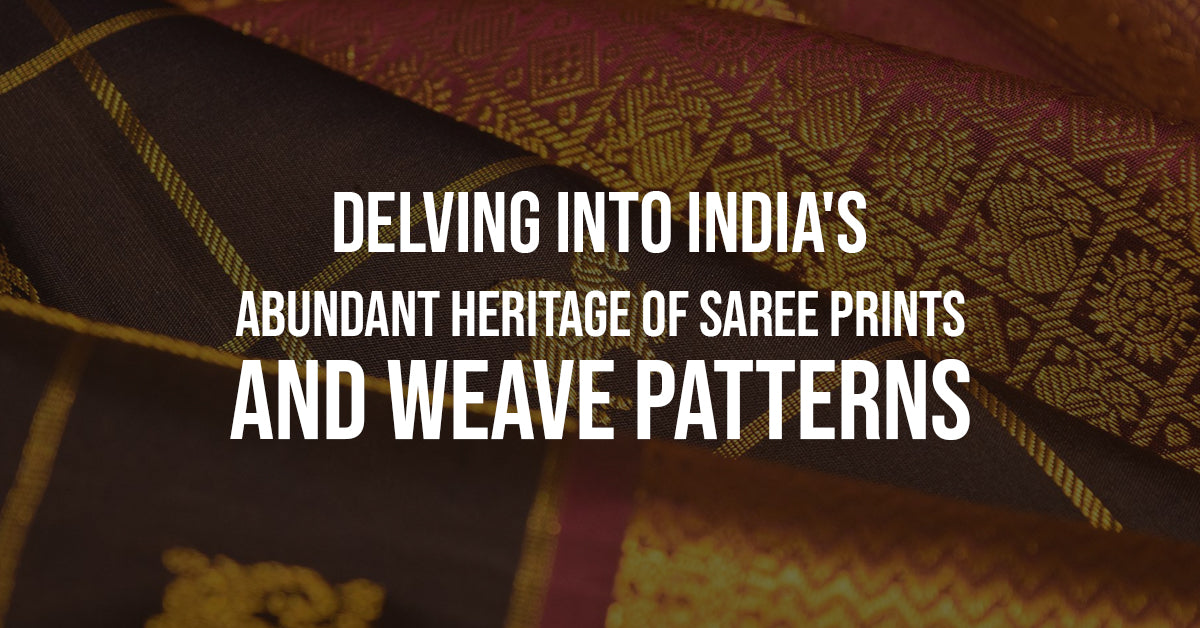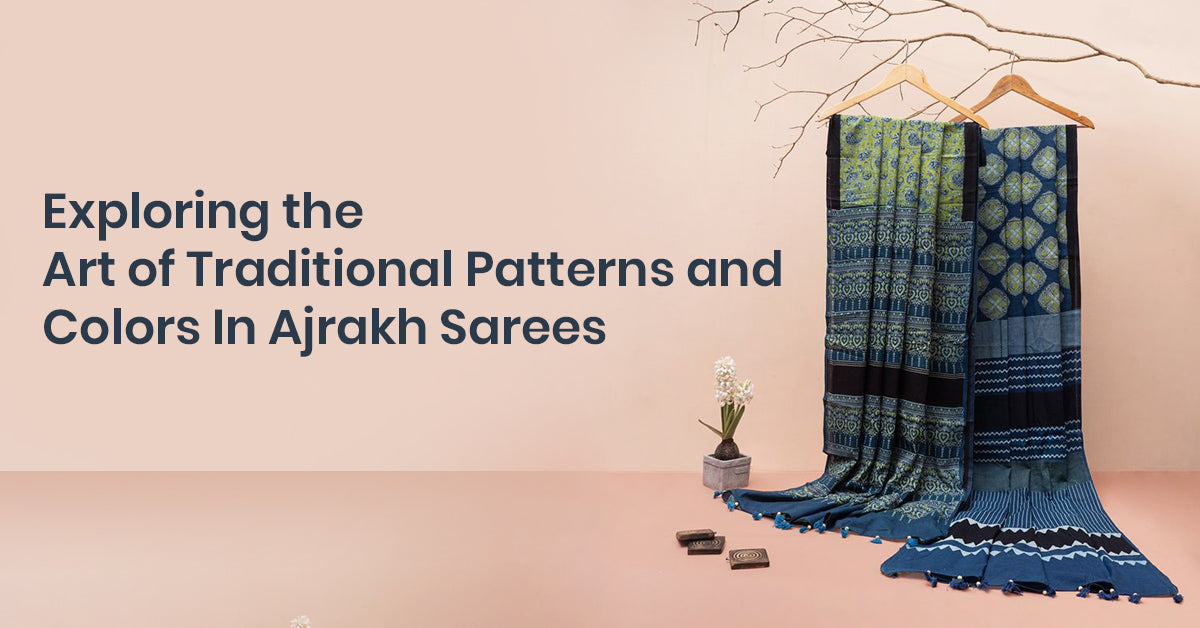Article: Delving Into India's Abundant Heritage Of Saree Prints And Weave Patterns

Delving Into India's Abundant Heritage Of Saree Prints And Weave Patterns
Delving Into India's Abundant Heritage Of Saree Prints And Weave Patterns
India's cultural diversity is beautifully reflected in its traditional attire, with the saree as an emblem of grace, elegance, and tradition. Saree prints are deeply rooted in the country's rich cultural heritage, reflecting its history, mythology, and natural surroundings. India is renowned for its exquisite handloom sarees, each showcasing unique prints and weaving patterns passed down through generations. Let's journey through India's rich heritage of saree prints and woven patterns, celebrating the intricate artistry passed down through generations.
Kanjeevaram Sarees:
Kanjeevaram sarees, also known as Kanchipuram silk sarees, are among the most revered sarees in Tamil Nadu and across India. Lustrous silk fabric, rich color combinations, and intricate zari work characterize these sarees. These sarees are handwoven using pure silk threads and embellished with rich zari work. They often feature traditional motifs such as temples, peacocks, mangoes, and floral designs. These motifs are inspired by the rich cultural heritage of Tamil Nadu, including its temples, mythology, and natural landscapes. The Kanjeevaram weave is celebrated for its durability, lustrous texture, and timeless appeal, making it a cherished heirloom for generations.
Chettinad Cotton Sarees:
Chettinad cotton saree is famous for its simplicity, comfort, and elegant prints. They are traditionally handwoven in the Chettinad region of Tamil Nadu using pure cotton yarns. These sarees are woven using fine cotton yarns and often feature bold and intricate designs that reflect the region's cultural heritage. One of the most characteristic weave patterns found in Chettinad cotton sarees is the "Kandaangi" or "Kandangi" pattern.
The Kandaangi weave pattern is distinctive for its checkered or checked design, created using contrasting colors of yarn. This pattern typically consists of small squares or checks woven into the fabric, resulting in a visually appealing and geometrically intricate design. The checks may vary in size and color combinations, offering various options for saree designs.
The prints on Chettinad handloom sarees often feature traditional motifs such as checks, stripes, and geometric patterns. These timeless prints reflect the region's architectural heritage, with motifs inspired by the intricate patterns found in Chettinad mansions and temples. These sarees are prized for their comfort, versatility, and rustic charm, reflecting the essence of rural Tamil Nadu.
Maheshwari Silk Cotton Sarees:
Maheshwari textiles are famous for their unique prints and distinct weave patterns. The prints are often characteristic of traditional motifs like peacocks, plant life, or geometric shapes rendered in colorful shades. The weave of Maheshwari material is unique, incorporating a subtle combo of silk and cotton, with motifs like checks, stripes, and unique “Pallu” borders. These unique patterns are created using various techniques and hand block printing to withstand dyeing and embroidery. These Maheshwari silk cotton sarees replicate the rich cultural background of Maheshwar, Madhya Pradesh, where professional artisans have been generating these fabrics for generations, preserving a beautiful culture.
Mangalagiri Cotton Sarees:
Mangalagiri, in Andhra Pradesh known for its excellent handloom textiles, focuses on prints and weaving styles showcasing its cultural background. The place is renowned for its Kalamkari artistry, proposing intricate hand-painted motifs like floral designs and mythological figures. Mangalagiri fabrics are also distinguished by their striking zari paintings, incorporating gold and silver threads for a royal finish. These textiles are often seen in geometric styles and colorful hues, reflecting the place's rich weaving traditions. The artistry of Mangalagiri cotton sarees remains enchanted with its undying beauty and craftsmanship.
Chanderi:
Chanderi, known for its unique prints and weave patterns. The material is historically handwoven with a mix of silk and cotton. Chanderi's prints often include motifs like peacocks, plants, or geometric designs crafted using block or screen printing strategies. The weave patterns include 'Butis' (small motifs) or 'Bootis' (floral designs) woven into the material. The typical effect is a blend of sophistication and artistry, making Chanderi fabrics quite chosen for sarees and clothes. This historical artwork shape continues to conform to cutting-edge effects, even retaining its classic allure.
Narayanpet:
Narayanpet, in Telangana, India, is renowned for its precise handloom weaving lifestyle. The region is known for generating cotton sarees adorned with exclusive geometric patterns and colorful shades. One of the excellent weaving strategies in Narayanpet involves "Jamdani" weaving, where the designs are included in the fabric during the weaving procedure. The prints and weave patterns of Narayanpet sarees often feature motifs like checks, stripes, and temple borders.
Ikkat:
Ikkat is a conventional dyeing technique utilized in fabric layout, especially in India, Indonesia, and Central Asia. It includes tying off sections of yarn before dyeing, resulting in complicated styles while woven. The dye penetrates the untied sections, growing distinctive blurred motifs. This method is known for its unique, geometric, or summary styles, and the complexity of designs can vary from simple to highly intricate designs. The process is known for unique craftsmanship and creates fabric like sarees, scarves, and fabric. Ikkat prints showcase the artistry and ability of the weavers, often conveying cultural symbolism and nearby aesthetics.
Mul:
Mul often features vibrant prints and intricate woven patterns. Block printing is a common technique for creating unique designs on Mul fabric. Artisans carve intricate patterns onto wooden blocks, then dipped in dye and stamped onto the fabric, resulting in beautiful motifs like paisleys, florals, and geometric shapes. Weaving patterns on Mul involve skilled techniques like Jamdani, where delicate motifs are woven directly into the fabric using a supplementary weft technique. These patterns add depth and character to Mul, making it the most preferred fabric for clothing that reflect India's rich textile heritage.
Other Weaves & Prints Around India:
Embroidery Extravaganza:
Embroidery has been an integral part of Indian textiles for centuries, with each region boasting its unique styles and techniques. From the intricate Chikankari work of Lucknow to the vibrant Phulkari embroidery of Punjab, Indian sarees are adorned with exquisite handwork that adds a touch of elegance and charm. The fine thread work, inspired by nature, mythology, and everyday life, showcases the artistic prowess of Indian artisans..
Block Printing:
Originating in Rajasthan and Gujarat, block printing is a centuries-old technique that involves hand-carved wooden blocks dipped in natural dyes to create intricate patterns on fabric. The rich cultural heritage of these regions is depicted through motifs like paisleys, floral designs, and geometric patterns. The vibrant colors and intricate detailing make block-printed sarees like Bandhani and Bagru prints cherished pieces of wearable art.
Tie & Dye:
Tie and dye, or 'Bandhani' as it is known in India, is an ancient textile art form that involves tying small portions of the fabric with threads and then dyeing it to create vibrant patterns. Indigenous to Gujarat and Rajasthan, Bandhani sarees feature intricate patterns like dots, waves, and squares, reflecting the skilled craftsmanship of artisans. These sarees are often adorned with mirrors, beads, and sequins, adding a touch of glamor to traditional attire.
The weave patterns of Indian sarees are a testament to the region's rich cultural heritage and artisanal excellence. From the luxurious bridal Kanjivaram sarees to the rustic Chettinad cotton sarees, each saree carries centuries of tradition, craftsmanship, and regional identity. By celebrating and preserving these timeless art forms, we at Thenmozhi Designs honor the legacy of India’s weaving heritage and support the livelihoods of countless artisans who continue to keep these traditions alive.

